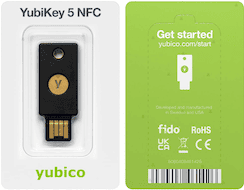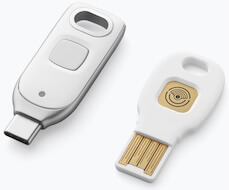What Are Passkeys?
Passkeys are a modern authentication method designed to replace traditional passwords. They represent the next evolution in secure login technology, offering a simpler user experience with significantly enhanced security.
Key Point:
Unlike passwords, passkeys never leave your device and cannot be phished, stolen in data breaches, or reused across services.
Developed by the FIDO Alliance (Fast Identity Online) in collaboration with industry giants like Apple, Google, and Microsoft, passkeys are now supported by most major platforms and are rapidly being adopted by leading online services.
Passwordless Future
Passkeys represent the industry's commitment to moving beyond passwords entirely, addressing the fundamental security flaws inherent in password-based authentication.
How Passkeys Work
Passkeys function based on the WebAuthn standard (Web Authentication) and FIDO2 technology. Instead of sharing a secret (password) with websites, passkeys use public key cryptography:
- Key Pair Generation: When you create a passkey, your device generates a unique public-private key pair specifically for that website or app.
- Private Key Storage: The private key always stays on your device or within your platform's secure syncing system (like iCloud Keychain, Google Password Manager).
- Public Key Registration: Only the public key is shared with the service, which it stores to verify your future logins.
- Authentication: When logging in, the service sends a challenge to your device, which is signed using your private key, and the service verifies the signature with your public key.
- Device Verification: Access to your private key is protected by your device's authentication method (fingerprint, face scan, PIN).
Technical Components
- FIDO2: The overarching standard for passwordless authentication
- WebAuthn: The web API that allows websites to implement passkey authentication
- CTAP: Client to Authenticator Protocol - enables communication with external authenticators
- Authenticator: Your device or security key that holds the private keys
Traditional Passwords
Shared secret
Passkeys
Public key cryptography
This approach ensures that even if a service is compromised, attackers gain access only to public keys, which are useless without the corresponding private keys securely stored on your devices.
Benefits Over Passwords
Phishing Resistance
Unlike passwords, passkeys are bound to specific websites. Even if you're tricked into visiting a fake site, your passkey for the legitimate site won't work there.
Data Breach Protection
When services are hacked, no sensitive passkey data is compromised. Only public keys are stored server-side, which are useless to attackers without the private keys.
Simplified Experience
No more memorizing complex passwords. Authentication is handled by your device's biometrics or PIN - the same method you use to unlock your phone or computer.
Cross-Device Synchronization
Modern passkey implementations (via Apple, Google, or Microsoft) securely sync your credentials across devices, providing convenience without compromising security.
Advantages for Organizations:
- Reduced customer support costs for password resets
- Lower risk of account takeovers and fraud
- Improved user experience leading to higher conversion rates
- Compliance with evolving security standards and regulations
Platform Implementation
The three major platform providers have worked together to ensure passkeys become a universal standard. Here's how each platform implements passkey technology:
Apple Passkeys
Apple implements passkeys through iCloud Keychain, allowing seamless synchronization across all Apple devices signed into the same Apple ID.
- Supported on iOS 16+, macOS Ventura+
- Uses Face ID or Touch ID for biometric verification
- Handles cross-device authentication through Apple's Handoff technology
- Passkeys can be viewed and managed in Settings → Passwords
Google Passkeys
Google's implementation stores passkeys in Google Password Manager, with synchronization across Android devices and Chrome browsers.
- Supported on Android 9+ and Chrome on all platforms
- Uses fingerprint, face recognition, or screen lock for verification
- Cross-device flow with QR code scanning for non-Google platforms
- Managed in passwords.google.com or device settings
Microsoft Passkeys
Microsoft integrates passkeys with Microsoft Authenticator and Windows Hello, supporting both consumer and enterprise scenarios.
- Supported on Windows 10/11 with Windows Hello
- Expanded to Microsoft accounts and Microsoft Authenticator app
- Integration with Azure AD for enterprise use cases
- Managed through account.microsoft.com or device settings
These platforms also support using passkeys across ecosystems. For example, you can use Google passkeys on an Apple device through a cross-platform authentication flow or a hardware security key.
Setting Up Passkeys
The process for setting up passkeys varies slightly depending on the platform and service, but generally follows these steps:
Creating Your First Passkey
- Visit a supporting website and go to account security settings or during sign up/sign in.
- Look for passkey options such as "Create a passkey," "Set up passwordless login," or similar options.
- Authenticate with your device using biometrics (Face ID, Touch ID, fingerprint) or device PIN.
- Confirm passkey creation - your device will handle the technical aspects of key generation.
- Verification complete - your passkey is now created and linked to your account.
Apple Devices Setup
- Ensure iOS 16+ or macOS Ventura+
- Sign in to your Apple ID
- During website registration, choose "Create passkey"
- Verify with Face ID/Touch ID
- Passkey automatically syncs to your Apple devices
Android Devices Setup
- Ensure Android 9+ with Google Play Services
- Sign in to your Google account on device
- Choose "Create passkey" on supported site
- Verify with fingerprint/face/screen lock
- Passkey saved to Google Password Manager
Using Passkeys Across Devices
When signing in on a new device:
- Enter your username on the login screen
- If prompted to use a passkey from another device:
- Scan the displayed QR code with your phone
- Verify with biometrics on your phone
- Authentication will complete automatically
- For same-ecosystem devices, the process may be automatic
Pro Tip:
Consider creating a passkey on a hardware security key as a backup in case you lose access to your devices or accounts.
Major Services Supporting Passkeys
Passkey adoption is growing rapidly among major online services. Here are some notable platforms that already support passkey authentication in 2025:
All Google services
Apple
Apple ID & services
Microsoft
Microsoft accounts
PayPal
Payment services
eBay
Marketplace
Shopify
E-commerce platform
Social media
Social media
Amazon
Shopping
Spotify
Music streaming
Dropbox
Cloud storage
GitHub
Code repositories
2025 Adoption Trends
In 2025, passkey adoption has expanded significantly across industries:
- Banking & Finance: Major banks now offer passkey login for improved security
- Healthcare: Patient portals increasingly support passkeys for HIPAA compliance
- Government Services: Some government digital services now accept passkeys
- E-commerce: Most major retailers support passkeys for checkout security
- Enterprise Systems: B2B platforms increasingly offer passkey authentication
Hardware Security Keys
Hardware security keys provide a physical alternative for storing passkeys, offering enhanced security and a backup option if you lose access to your primary devices.

YubiKey
Industry-leading security keys from Yubico with FIDO2 support, available in various form factors including USB-A, USB-C, NFC, and Lightning.
Learn more about YubiKey →
Google Titan
Google's own security key line with FIDO2 certification, featuring USB-C, USB-A, and Bluetooth options for versatile authentication.
Learn more about Titan Keys →
Nitrokey
Open-source security keys with FIDO2 compliance, focusing on transparency and auditability for security-conscious users.
Learn more about Nitrokey →Key Features to Consider
- Connectivity: USB-A, USB-C, NFC, Bluetooth, Lightning
- Portability: Size, keychain options, durability
- Biometric: Some keys offer fingerprint verification
- Multi-protocol: Support for FIDO2, U2F, PGP, etc.
- Battery life: For Bluetooth models
- Price range: $25-$85 depending on features
Using Hardware Keys with Passkeys:
- Purchase a FIDO2-compatible security key
- During passkey creation, select the option to use a security key
- Follow prompts to connect your key and set it up
- Store your security key in a safe place as a backup
Enterprise Adoption
For businesses, passkeys offer significant security improvements while reducing IT support costs. Here's how enterprises can implement passkey technology:
Enterprise Implementation Roadmap
- Assess Technical Requirements
Evaluate your identity provider's passkey support and ensure your applications can work with WebAuthn.
- Start with Pilot Groups
Begin with IT staff or tech-savvy departments to identify integration challenges.
- Develop Recovery Procedures
Create processes for handling device loss, employee turnover, and account recovery.
- User Training
Educate employees on the benefits and usage of passkeys through documentation and workshops.
- Full Deployment
Roll out company-wide with support channels in place for user assistance.
Enterprise Platform Support
Microsoft Entra ID (Azure AD)
- Passkey support for workforce identities
- Integration with Windows Hello for Business
- Conditional Access policy integration
Google Workspace
- Passkey management via admin console
- Deployment controls for organizations
- Security reporting and attestation
Okta
- WebAuthn passkey integration
- Progressive enrollment options
- Centralized management and reporting
Auth0
- FIDO2 authenticator support
- Customizable authentication flows
- Developer-friendly API documentation
Business Benefits:
- Reduced costs: 50-70% fewer password reset tickets
- Enhanced security: Elimination of password-based attacks
- Improved compliance: Meets latest regulatory requirements
- User satisfaction: Simplified login experience for employees
Future of Authentication
While passkeys represent a significant improvement over passwords, the authentication landscape continues to evolve. Here's what to expect in the years ahead:
Continued Convergence
We'll see further integration between platform authenticators, with improved cross-platform experiences and interoperability becoming the norm rather than the exception.
Enhanced Biometrics
Advancements in biometric technology will make authentication even more seamless, with innovations like passive continuous authentication based on behavior patterns.
Decentralized Identity
Blockchain-based identity systems may complement passkeys, giving users more control over their digital identity and how it's shared across services.
Regulatory Frameworks
Government regulations around digital identity and authentication will continue to evolve, potentially making passwordless authentication a compliance requirement.
Authentication Timeline
2020-2022: Passwordless Foundations
FIDO2 standards mature, platform support begins
2023-2025: Passkey Mainstream Adoption
Cross-platform support, consumer awareness grows
2026-2028: Advanced Biometric Integration
Behavioral biometrics, contextual authentication
2029+: Decentralized Identity Ecosystem
User-controlled identity becomes mainstream
Preparing for the Future
To stay ahead of authentication trends:
- Embrace passkeys now as they become the new standard
- Consider hardware security keys as a reliable backup option
- Follow updates from the FIDO Alliance and platform providers
- Participate in early access programs for new authentication technologies
- Advocate for passwordless adoption in your organization
Conclusion
Passkeys represent a significant leap forward in authentication technology, addressing the fundamental flaws of passwords while improving user experience. By eliminating phishing vulnerabilities, preventing credential stuffing attacks, and removing the burden of password management from users, passkeys are positioned to become the new standard for online authentication.
As more services adopt passkey support, users will gradually transition to a passwordless future where security and convenience are no longer trade-offs but complementary aspects of the authentication experience.
Whether you're an individual user looking to enhance your personal security or an organization seeking to strengthen your authentication infrastructure, passkeys offer a compelling solution that's accessible today.
Additional Resources
- FIDO Alliance
Official site of the organization behind the FIDO2 standards
- Google Passkeys Developer Guide
Developer documentation for implementing passkeys with Google
- Apple Passkeys Developer Guide
Resources for implementing passkeys in Apple's ecosystem
- Microsoft Passwordless Solutions
Overview of Microsoft's approach to passwordless authentication
- WebAuthn Guide
Comprehensive guide to understanding the WebAuthn standard